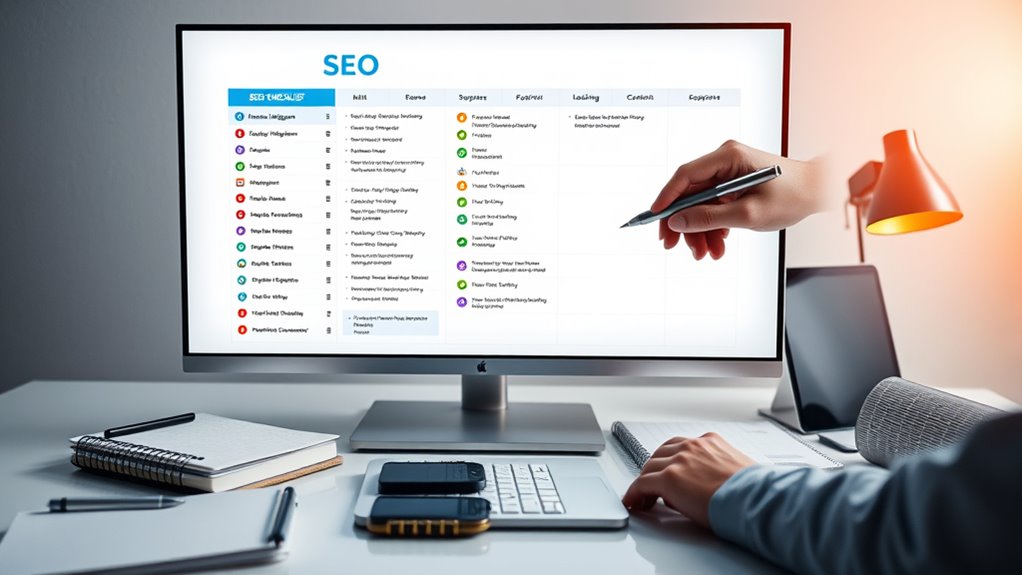To guarantee a smooth website migration, start with a thorough site audit to identify issues and optimize your existing setup. Then, back up all your data and plan URL redirects carefully to preserve SEO value. update internal links, ensure your site structure is clear, and improve speed and mobile responsiveness. Use testing tools to validate your migration and closely monitor key SEO metrics afterward. Keep following best practices to minimize disruptions and secure your rankings—more tips await if you continue.
Key Takeaways
- Conduct a comprehensive site audit and create a backup to ensure data integrity before migration.
- Develop a detailed URL redirection strategy using 301 redirects to preserve link equity.
- Optimize site structure and internal linking to facilitate seamless crawling and user navigation.
- Manage robots.txt and XML sitemaps effectively to control crawl behavior and improve indexation.
- Monitor key SEO metrics post-migration to identify and address issues promptly.
Conduct a Comprehensive Site Audit Before Migration

Before starting your website migration, you need to conduct a thorough site audit to identify existing issues and understand your current SEO performance. Focus on evaluating content relevance to guarantee your pages deliver value and align with user intent. Check for gaps or outdated information that could affect future rankings. Simultaneously, review keyword consistency across your site; inconsistent keyword usage can dilute SEO signals and confuse search engines. Analyzing these aspects helps you pinpoint areas needing improvement before migration, facilitating a smoother transition. Incorporating sound healing science principles can also provide insights into creating a harmonious user experience that promotes engagement and retention. Additionally, staying aware of crypto market trends can help anticipate external factors that might influence your SEO strategy during this process. Understanding your current content’s strengths and weaknesses, including content optimization, helps you plan adjustments that preserve or enhance your rankings post-migration. Conducting a comprehensive content audit enables you to identify which pages require updates or consolidations to improve overall site performance. Performing a technical SEO review can further ensure that your website’s infrastructure is prepared for the migration, minimizing technical issues that could harm your SEO. This exhaustive audit provides a solid foundation for optimizing your site and maintaining SEO integrity during the migration process.
Backup Your Existing Website and Data

Ensuring you have a complete backup of your website and data is a crucial step in any migration process. A reliable website backup safeguards your content, databases, files, and configurations, ensuring data safety if something goes wrong. Before making any changes, download and store copies of your site’s files and databases in a secure location. Use trusted backup tools or plugins compatible with your platform to automate the process and minimize errors. Confirm that your backup is recent and intact, so you can restore your website quickly if needed. Remember, a thorough backup not only protects your data but also provides peace of mind, allowing you to focus on the technical aspects of the migration without risking data loss. Additionally, understanding cookies and privacy implications can help you prepare for any compliance considerations during your migration process. Considering global variations in cotton candy flavors can also inspire you to tailor your website content to diverse audiences, enhancing user engagement. Incorporating knowledge about content quality and accuracy can further ensure your website remains reliable and trustworthy throughout the migration.
Map and Plan URL Redirects Strategically

Mapping and planning your URL redirects carefully is essential to maintain your site’s SEO authority and user experience during a migration. Start with thorough URL mapping by cataloging all existing URLs and deciding their new counterparts. Develop a clear redirect strategy by prioritizing important pages and avoiding redirect chains or loops. Use 301 redirects for permanent changes, ensuring search engines and users are directed to the correct pages. Consider implementing a redirect plan that preserves link equity and prevents loss of rankings. Test your redirects before launching to catch errors early. Proper URL mapping and a well-thought-out redirect scheme keep your site’s SEO intact, minimize traffic loss, and deliver a seamless experience for visitors during the transition. Paying attention to Relationship dynamics can help anticipate and address potential user concerns during this process. Additionally, understanding how juice cleanse and detox can influence overall health emphasizes the importance of clear, consistent messaging during website transitions to maintain user trust. Incorporating an understanding of website architecture can further optimize your redirect strategy, ensuring all pages are properly linked and accessible. Regularly reviewing your performance metrics during the migration can help identify issues early and allow for prompt adjustments. Moreover, staying informed about latest SEO practices can guide you in adapting your strategy to evolving search engine algorithms.
Update Internal Linking and Canonical Tags

Have you considered how your internal links and canonical tags impact your site’s SEO after a migration? Updating internal linking ensures that link equity flows correctly across your new website structure, preventing broken links and orphaned pages. Review and revise your internal links to point to the correct URLs, especially if URLs have changed. Additionally, update canonical tags to reflect your preferred versions of pages, avoiding duplicate content issues. Proper canonicalization signals to search engines which version to index, preserving your rankings. Make sure all internal links and canonical tags are consistent and accurate across your site. This step helps maintain your site’s authority and improves crawl efficiency after the migration, ensuring your SEO efforts remain effective in the new environment. Remember to verify that your vetted content remains relevant and authoritative, as this influences your site’s credibility and ranking. Incorporating structured data can further enhance search result appearances and support your SEO objectives, especially as AI-powered tools become more prevalent in optimizing websites. Additionally, reviewing your Zodiac compatibility insights can provide a unique perspective on how your content resonates with diverse audiences, fostering better engagement. Implementing security measures during the migration process can also protect your site from potential vulnerabilities and ensure data integrity.
Optimize Site Structure and Navigation for SEO

You need to create clear hierarchical menus that guide visitors and search engines through your site easily. Maintain a consistent URL structure to help both users and crawlers comprehend your content’s organization. Incorporating sound design principles into your site architecture can enhance user experience and page discoverability. Ensuring your site’s navigation tools are intuitive can significantly improve overall accessibility and SEO performance. Additionally, understanding the importance of Gold IRA rollovers can help you optimize your content for relevant search queries and improve your site’s authority in investment-related topics. Recognizing the significance of structured data can further enhance your site’s visibility in search results and improve click-through rates. Implementing user-friendly menus also contributes to better site navigation and SEO effectiveness.
Clear Hierarchical Menus
Why are clear hierarchical menus essential during a website migration? They help search engines understand your site’s structure, ensuring important pages get indexed correctly. A well-designed menu structure guides users seamlessly, reducing bounce rates. When your hierarchical menus are logical and easy to navigate, both users and crawlers find content faster. Here’s a simple breakdown of best practices:
| Level | Description | Example |
|---|---|---|
| 1 | Main categories | Products |
| 2 | Subcategories | Laptops, Tablets |
| 3 | Specific pages or filters | Gaming Laptops |
| 4 | Related content or accessories | Laptop Bags |
| 5 | Support or FAQs | Warranty Information |
Ensure your menu structure is consistent and clear, making it easier for search engines to crawl and rank your site effectively. Incorporating site structure principles can enhance your SEO performance during the migration process.
Consistent URL Structure
Maintaining a consistent URL structure is essential during a website migration because it helps search engines and users easily understand and navigate your site. Consistent URLs ensure that your site’s hierarchy remains clear and predictable, which benefits SEO and user experience. Use URL versioning to manage changes effectively, avoiding broken links or duplicate content. When updating URLs, keep them simple, descriptive, and keyword-rich where appropriate. Implement redirects from old URLs to their new counterparts to preserve link equity and prevent SEO loss. Stability in your URL structure makes it easier to track performance and troubleshoot issues later. Additionally, understanding site architecture and navigation can aid in planning an effective URL strategy that enhances crawlability and indexing. Properly structured URLs also facilitate content discoverability, making it easier for search engines to index your pages efficiently. By planning and maintaining consistent URLs throughout the migration, you help search engines recognize your site’s authority and improve overall crawlability. Additionally, understanding divorce laws and financial considerations can aid in managing the legal and financial aspects of your website’s content related to legal advice, ensuring accuracy and credibility.
Ensure Proper Implementation of Robots.txt and XML Sitemaps

Ensuring the proper implementation of robots.txt files and XML sitemaps is essential for guiding search engines effectively through your website. Proper robots.txt management controls which pages are crawled, preventing duplicate content or sensitive info exposure. Meanwhile, sitemap submission ensures search engines discover and index your new pages efficiently. Use a well-structured robots.txt file to block or allow specific directories, and verify it regularly. For XML sitemaps, submit them via Google Search Console and keep them updated with your latest URLs. Here’s a quick comparison:
| Aspect | Best Practice |
|---|---|
| Robots.txt management | Block irrelevant pages, allow essential ones |
| Sitemap submission | Submit and update after migrations |
| Indexing control | Use robots meta tags for granular control |
This approach maximizes crawl efficiency and supports your migration success.
Check and Improve Site Speed and Mobile Responsiveness

You need to optimize your site’s loading times to keep visitors engaged and improve rankings. Enhancing mobile layouts guarantees your site looks great and functions smoothly on all devices. Additionally, minimizing redirects reduces delays and boosts overall performance.
Optimize Loading Times
Optimizing loading times is essential for a smooth user experience and better search engine rankings, especially during a website migration. Start by implementing lazy loading to delay non-essential images and content until needed, reducing initial load times. Focus on image optimization by compressing images without sacrificing quality and using the correct formats to accelerate page rendering. Additionally, review your hosting environment and leverage CDN services to deliver content faster worldwide. Minimize JavaScript and CSS files by combining and minifying them, ensuring quicker load speeds. Regularly test your site’s performance with tools like Google PageSpeed Insights or GTmetrix, and address any bottlenecks. These steps will help you maintain ideal load times, ensuring your visitors stay engaged and your SEO remains strong.
Enhance Mobile Layouts
Are mobile users experiencing slow load times or layout issues? If so, it’s time to enhance your mobile layouts. Confirm your site employs a responsive design that adapts seamlessly to different screen sizes and devices. Check that your pages load quickly on mobile by optimizing images, leveraging browser caching, and minimizing code. Incorporate touch-friendly features, like large buttons and easy-to-navigate menus, so users can interact effortlessly. Test your mobile responsiveness regularly with tools like Google’s Mobile-Friendly Test, and fix any layout shifts or responsiveness problems. By prioritizing a smooth, mobile-optimized experience, you’ll reduce bounce rates and boost user engagement, making your website more attractive to both users and search engines.
Minimize Redirects
Minimizing redirects is essential for maintaining fast site speeds and ensuring a smooth mobile experience. Redirect chains and duplicate redirects can slow down your site and harm user experience. To optimize, focus on these three steps:
- Eliminate redirect chains by reducing multiple sequential redirects to a single step.
- Identify and fix duplicate redirects that cause unnecessary loops and delays.
- Update internal links to point directly to the final destination URL, avoiding intermediate redirects.
Monitor and Validate Migration With Testing Tools

To make certain your website migration goes smoothly, it’s vital to actively monitor and validate the process using testing tools. Start with A/B testing to compare pre- and post-migration versions, identifying any issues that affect user experience or SEO. Use crawling tools to analyze your site’s crawl budget, ensuring search engines can efficiently index your new pages without unnecessary duplication or errors. Regularly check for broken links, duplicate content, or missing pages that could harm your rankings. Validate that redirects work correctly and that your structured data remains intact. By continuously testing and validating, you catch potential problems early, minimizing SEO disruptions and ensuring your migration’s success. This proactive approach keeps your site healthy and search-engine friendly throughout the transition.
Track Key SEO Metrics Post-Migration

After your migration, you need to keep a close eye on your organic traffic to spot any drops or changes quickly. Analyzing your conversion rates helps you understand if visitors are taking the desired actions on your new site. Tracking these key metrics guarantees you can address issues promptly and measure the success of your migration.
Monitor Organic Traffic
How can you tell if your website migration is successful? By monitoring your organic traffic, you gain clear insights into your SEO health. Keep an eye on key metrics like:
- Changes in keyword rankings to see if your target keywords maintain or improve their positions.
- Fluctuations in your backlink profile, ensuring backlinks aren’t lost or devalued.
- Overall organic traffic volume, measuring if visitors are returning and engaging.
Consistent tracking helps you identify dips early and adjust your strategy accordingly. If traffic drops markedly, check your keyword rankings and backlink profile to pinpoint issues. Staying vigilant ensures your migration strengthens, rather than weakens, your SEO performance.
Analyze Conversion Rates
Ever wonder whether your website migration actually boosts your business? Analyzing conversion rates helps you determine if your efforts improve user engagement and drive desired actions. After migration, track key SEO metrics like conversion optimization, bounce rates, and goal completions to gauge success. Compare pre- and post-migration data to identify trends and areas needing improvement. Use tools like Google Analytics to monitor how visitors interact with your site and where they drop off. If conversions decline, review your content, user experience, and technical setup to pinpoint issues. Regularly analyzing these metrics guarantees you’re on the right path toward maximizing user engagement and achieving migration goals. Ultimately, this helps you refine your strategy for better results and sustained growth.
Maintain and Update SEO Best Practices During and After Transition

To guarantee your SEO efforts remain effective throughout and after a website migration, you need to proactively maintain and update your SEO best practices. Focus on three key areas:
Ensure ongoing SEO success during website migration by proactively updating content, preserving backlinks, and adapting strategies as needed.
- Keep content fresh by regularly updating existing pages and adding new, relevant information to boost content freshness.
- Monitor and preserve backlinks, ensuring that valuable links are maintained or redirected to retain authority.
- Review your SEO strategies, adjusting for any changes in algorithms or user behavior, to stay aligned with current best practices.
Frequently Asked Questions
How Long Should I Monitor My Website After Migration?
After your migration, you should monitor your website for at least 4-6 weeks. During this period, conduct regular content audits to verify all content displays correctly and analyze backlinks to identify any lost or broken links. Keep an eye on your analytics and search console data, making adjustments as needed. Continuous monitoring helps you catch issues early, ensuring your site maintains its SEO performance and recovers smoothly from any post-migration hiccups.
What Are Common Signs of SEO Issues Post-Migration?
Think of your site as a car on a long journey—you’ll notice signs if something’s wrong. Common SEO issues post-migration include a site audit revealing crawling errors, a sudden traffic decline, or drops in rankings. You might also see broken links or missing pages. Keep a close eye on analytics and perform regular site audits to catch these problems early, so you can steer back on course quickly.
How Do I Handle Duplicate Content During Migration?
When handling duplicate content during a migration, you should implement canonical tags on your pages to tell search engines which version is primary. Also, carefully plan URL restructuring to avoid creating multiple URLs with similar content. This way, you prevent duplicate issues from damaging your SEO. Regularly audit your site post-migration to ensure canonical tags are correctly set and URL restructuring is properly managed.
What Tools Are Best for Tracking SEO Performance?
To track your SEO performance effectively, you should use tools that focus on keyword tracking and backlink analysis. Google Search Console offers valuable insights into your rankings and site health, while platforms like SEMrush or Ahrefs provide extensive keyword tracking and backlink analysis. These tools help you monitor your progress, identify issues, and refine your strategy, ensuring your migration maintains or improves your search visibility.
When Should I Consider a Complete Website Redesign Instead of Migration?
Did you know that 38% of users stop engaging with a website if the layout is unattractive? You should consider a complete redesign when branding considerations and user experience no longer correspond with your goals. If your site feels outdated, difficult to navigate, or weakens your brand’s image, a redesign offers a fresh start. It guarantees your website effectively communicates your brand and provides a seamless user experience, boosting engagement and conversions.
Conclusion
Think of your website migration as steering a ship through uncharted waters. With your checklist in hand, you’re equipped to navigate smoothly, avoiding hidden reefs and storms. Stay vigilant, monitor your course, and make adjustments as needed. When you reach your destination, you’ll find your new site thriving—just like a well-charted voyage ending in calm seas. Keep your SEO compass steady, and success will be yours beyond the horizon.









